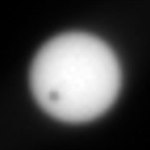Wikijunior:Solar System/Mars/Deimos
Deimos Facts:
- Deimos is one of the smallest moons in the Solar System.
- Deimos has a satellite named after it, Deimos-1.
- Most people could sprint out of Deimos' gravitational zone.

How big is Deimos?
[edit | edit source] |
| Mars |
Deimos is one of the smallest moons in the solar system, at only 12 km in diameter, or about 1/2 the diameter of Phobos. Surprisingly, however, Deimos was spotted and identified as a moon before Phobos, partly because of its greater distance from Mars, which meant that it was not so hidden in the glare of Mars' light. The surface area of Deimos is roughly the size of a medium-sized city on Earth. It is also very irregular in shape due to its small size.
From the viewpoint of somebody standing on Mars, Deimos would appear almost as just a very bright star, and you would not be able to identify any surface features without a telescope.
What is its surface like?
[edit | edit source]
The surface of Deimos has no atmosphere of any kind, and it is full of craters from meteors hitting the surface, just like the Earth's Moon. The surface of Deimos is made up of very dark rocks called carbonaceous chondrite, which includes a lot of the element carbon. There is also water ice on the surface of Deimos, as well as most of the interior.
Deimos has two named craters: Swift and Voltaire. Swift is named after Irishman Johnathan Swift (1667–1745), the author of Gulliver's Travels. Swift is the smaller out of the two named craters, having a 1000 m diameter, while Voltaire has a 1900 m diameter. The person Voltaire (1694–1778) was a French supporter of freedom of religion and freedom of expression.
Because Deimos is so small, the gravity on Deimos is very, very small. It is about 1/2500th of the force of gravity here on Earth. This is so little gravity that it would be very dangerous for people to walk on the surface without a tether or some other restraint to keep them from pushing themselves completely away from Deimos. If there were a structure on Deimos built for humans, it would resemble an orbital space station inside.
Because Deimos is tidally locked to Mars, it always keeps one side facing Mars during its entire orbit. This means that if you were on the side facing Mars, you would always see Mars in the same part of the sky all of the time. The other side would never see Mars in the sky. On the side facing Mars, the view of Mars itself takes up almost one eleventh of the sky, so Mars itself would be a very significant object to look at.
One of the reasons why scientists are interested in exploring Deimos is because it is believed to be an asteroid that was captured by Mars many millions of years ago. By studying Deimos and its brother moon Phobos, scientists hope to get a very close view of what other asteroids of a very similar size also look like elsewhere in the Solar System.
How long is a day on Deimos?
[edit | edit source]A "day" on Deimos lasts about 30.5 hours.
How long is its orbit around Mars?
[edit | edit source]Deimos is tidally locked to Mars, so a day on Deimos is precisely the same as the time it takes to orbit Mars. From the surface of Mars, Deimos still appears to rise from the east and set in the west like the Sun, planets, and everything else in the sky (except Phobos), but it lingers in the sky for a very long time, taking almost 3 sols (Martian days) before it sets in the western sky.

Does Deimos cause a solar eclipse on Mars?
[edit | edit source]Just as the Earth's Moon can come between the Earth and the Sun, Deimos occasionally comes between Mars and the Sun. This is also called a transit, and in this case perhaps transit is a more appropriate term than eclipse.
Because Deimos is so tiny and relatively far away from Mars as well, the portion of the Sun that is covered by Deimos during an eclipse is very small, and somebody standing on the ground on Mars would hardly even notice it. It is similar to taking a flashlight and putting a small pebble on it. You can't see much difference in the light that comes from the flashlight.
Who is it named after?
[edit | edit source]Deimos (Ancient Greek Δεῖμος) is named after the Greek son of Ares (the Greek name for Mars), who is also called "panic" or even "dread". In Greek mythology, Deimos was the personification of terror. Deimos, together with Phobos and others, would often accompany Ares into battle with the gods.

How was it discovered?
[edit | edit source]Asaph Hall was an astronomer with the United States Naval Observatory, where he studied many of the planets and objects in the Solar System. In 1877, he discovered both Deimos and, less than two hours later, Phobos and classified them as moons of Mars. The name for Deimos was suggested by Henry Madan based on the book Iliad, a classical Greek book about mythology.